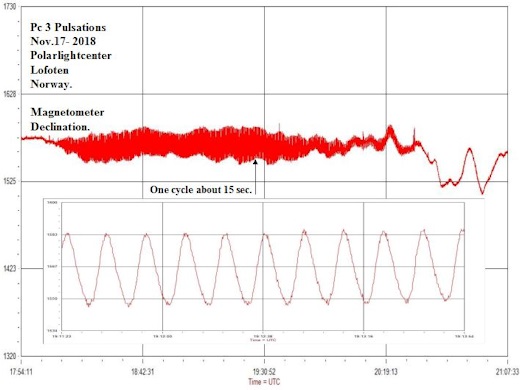Nå begynner det å gå seg til for Pythagoras` teori om at universet er musikalsk og at skapelsen (og vi) bygger på lyd og vibrasjoner!
På Spaceweather skriver dem i dag at et observatorium i Tromsø fanget den 18. november opp eksepsjonelt rene sinusbølger i jordens magnetiske felt. De musikalske bølgene varte i flere timer og hadde så og si perfekt tonehøyde.
De forklarer at vanligvis når solvind treffer jorden, svinger nålene på måleinstrumentene kaotisk frem og tilbake. Den 18. november skjedde noe ganske annerledes. Da solvinden traff denne dagen skapte den i stedet rene musikalske bølger!

Som jeg har skrevet så handler det i vår tid om å gjenoppdage gamle kunster. Pythagoras (Numerologiens far) lærte bort kunnskapen om Sfærenes harmoni og det musikalske univers for over 2500 år siden. Han lærte sine elever at universet er musikalsk og at hvert individ er en særegen toneart/vibrasjon. https://en.wikipedia.org/wiki/Musica_universalis
Artikkelen er gjengitt i sin helt på engelsk under.
Aktuelle åpne artikler på Numerologen
- https://www.numerologensverden.no/hva-er-numerologi-2/
- https://www.numerologensverden.no/pythagoras/
- https://www.numerologensverden.no/432-hz-den-tapte-harmoniske-frekvens/
- https://www.numerologensverden.no/koblingen-mellom-bevissthet-jordens-magnetiske-felt-og-hyperkommunikasjon-gjenoppdaget/
- https://www.numerologensverden.no/solstormer-paavirker-menneskekroppen
Lagt inn 23/11-2018.
THE NEXT SOLAR WIND STREAM: Another stream of solar wind is approaching Earth. Estimated time of arrival: Nov. 26nd. The gaseous material is flowing from a sinuous hole in the sun’s atmosphere, south of the heliographic equator. It is not expected to spark a full-fledged geomagnetic storm. However, polar auroras are likely when the solar wind arrives. Free: Aurora Alerts
A RARE WAVE IN EARTH’S MAGNETIC FIELD: When a stream of solar wind hits Earth, magnetometers around the Arctic Circle normally go haywire, their needles swinging chaotically as local magnetic fields react to the buffeting of the solar wind. On Nov. 18th, however, something quite different happened. Solar wind hit Earth and produced … a pure, almost-musical sine wave:
Rob Stammes recorded the event from the Polarlightcenter, a magnetic observatory in the Lofoten Islands of Norway. «A very stable ~15 second magnetic oscillation commenced and persisted for several hours,» he says. «The magnetic field was swinging back and forth by 0.06 degrees, peak to peak, with the regularity of a metronome.»
Imagine blowing across a piece of paper, making it flutter with your breath. The solar wind can have a similar effect on magnetic fields. The waves Stammes recorded are essentially flutters propagating down the flanks of Earth’s magnetosphere excited by the breath of the sun. Researchers call them «pulsations continuous» — or «Pc» for short.
«A very sensitive magnetometer is required to record these delicate waves,» says Stammes. «I use a mechanical magnetometer with bar magnets suspended from a special wire. LEDs and light detectors in an isolated dark box record the motion of the magnets, while vanes in oil damp out non-magnetic interference.»
Pc waves are classified into 5 types depending on their period. The waves Stammes recorded fall into the range 15 to 45 seconds–that is, Pc3. Researchers have found that Pc3 waves sometimes flow around Earth’s magnetic field and cause a «tearing instability» in our planet’s magnetic tail. This, in turn, can set the stage for an explosion as magnetic fields in the tail reconnect.
A quartet of NASA spacecraft recently flew through just such an explosion. Last week, researchers from the University of New Hampshire reported that four Magnetospheric Multiscale (MMS) spacecraft spent several seconds inside a magnetic reconnection event as they were orbiting through Earth’s magnetic tail. Sensors on the spacecraft recorded jets of high energy particles emerging from the blast site. One jet was aimed squarely at Earth and probably sparked auroras when it hit the upper atmosphere.
Stammes has recorded many Pc waves in the past, «but this is the first time I have detected category Pc3,» he says. «This was a very rare episode indeed.»